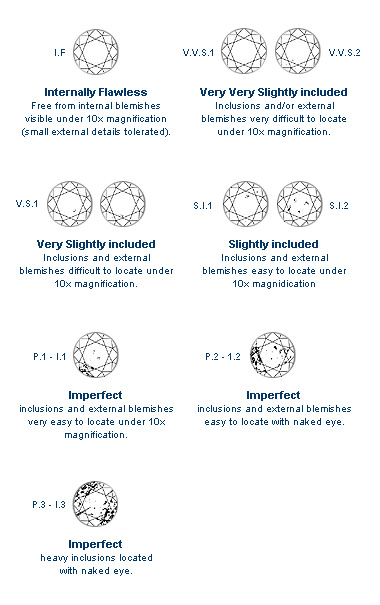London Antwerp Diamonds Ltd.
6, Laybourne House
Admirals Way
Canary Wharf
London E14 9UH
UK
tel.: 0044(0)20 7193 6052
welcome@londonantwerpdiamonds.com
| Home > Diamond Education > Clarity | |
When shopping for a diamond, the goal is to decide what level of these imperfections is appropriate for this particular purchase. A certain level of imperfections can be to your advantage since they act as a fingerprint to help identify your diamond. These imperfections can lower the price of the diamond to make it affordable without affecting its beauty to your eye. The position of an inclusion affects how readily it can be seen.
Cutters call the area seen through the table the heart of the stone and make every
effort to cut a stone so that inclusions are not visible through the table of
the finished stone. The preferred position for inclusions is under the bezel facets
or near the girdle because they are less noticeable there. • I.F.: internally flawless: •
V.V.S.1: very very slightly included: • V.V.S.2: very
very slightly included: • V.S.1: very slightly included:
•
V.S.2: very slightly included: • S.I.1: slightly included: •
S.I.2: slightly included: • P.1- I.1: imperfect: • P.2-
I.2: imperfect: • P.3- I.3: imperfect: The last two clarity steps are not sold at London Antwerp Diamonds The
following diagrams show what inclusions and blemishes look like in the different
clarity grades when viewed with 10X magnification. You can use a loupe or microscope
to see these characteristics, many of which will not be visible to the unaided
eye. Clarity
perception VS1 and VS2 graded stones have very small inclusions that are difficult to find even when viewed with 10X magnification. Typical inclusions are small crystals or feathers, distinct clouds and groups of pinpoints. They do not impact the diamond's beauty and are very high quality diamonds. SI1 and SI2 are the two most common grades for the typical buyer. These grades have inclusions or blemishes when viewed with 10X magnification. Most SI1 clarity diamonds should be "eye-clean," which means the flaws can't be seen with the unaided eye when viewed from the top. These are good quality diamonds and provide great beauty at a very reasonable price. Most SI2 clarity diamonds have inclusions visible to the unaided eye. Caution! There are some SI clarity diamonds that have inclusions easily visible to the unaided eye and should only be used for earrings or pendants, not for engagement rings. Advice: For diamonds with many facets (i.e., round brilliant), it is extremely difficult to see the difference between SI1 and higher grades even with a loupe or microscope. Therefore, target SI1 or VS2 as the best clarity values with outstanding beauty. For step cut shapes like emeralds and Asschers, we recommend at least VS2 clarity diamonds since these stones are so transparent and inclusions are easier to see with the eye. Diamond
care How to look If an inclusion is in this part of the diamond
and happens to be turned broadside to your view, it can be much more visible than
when viewed from the top where there are many facets to hide its appearance. If
the diamond is going to be visible from the side in the setting, make sure your
diamond is clean to the eye from the top and the side, regardless of what clarity
grade it has. | |

